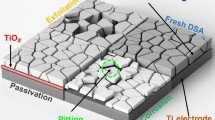Abstract
The cathodic reduction of Dy(III) ions at inert molybdenum and active gallium electrodes in molten NaCl–2CsCl eutectic and a temperature range of 843–973 K in an inert atmosphere is studied by stationary and nonstationary electrochemical methods. Anhydrous dysprosium trichloride (Aldrich) is used as received, and sodium and cesium chlorides are additionally purified from oxygen-containing impurities by directional crystallization. In addition, a zirconium getter is placed in an experimental cell to absorb the oxygen and moisture traces adsorbed on the inner walls of the quartz tube. One cathodic current peak corresponding to the reduction of Dy(III) ions to metallic dysprosium and one anodic peak associated with dysprosium dissolution are recorded on a cyclic voltammetric curve on the molybdenum electrode for NaCl–2CsCl–DyCl3 melt in the “electrochemical window” under study. Therefore, the reduction of Dy(III) ions to the metal proceeds in one step. Using diagnostic criteria, the reduction is found to be irreversible and controlled by the charge transfer rate. The diffusion coefficients of [DyCl6]3– ions are calculated. Their temperature dependence is described by the equation log D = –2.81 – 1920/T ± 0.02 and obeys the Arrhenius law. The temperature dependence of the apparent standard potential of the Dy(III)/Dy couple is determined using open-circuit potentiometry and described by the linear equation \(E_{{{\text{Dy}}\left( {{\text{III}}} \right)/{\text{Dy}}}}^{{\text{*}}}\) = –(3.827 ± 0.005) + (6.6 ± 0.1) × 10–4T ± 0.003 V. The changes in the apparent standard Gibbs energy, enthalpy, and entropy of dysprosium trichloride formation from elements in molten NaCl–2CsCl eutectic are determined. The alloy formation preceding the formation of metallic dysprosium at the cathode is observed on the cyclic voltammetric curve recorded at the gallium electrode for the NaCl–2CsCl–DyCl3 melt. The temperature dependence of the apparent standard potential of a Dy–Ga alloy is established using open-circuit potentiometry. This dependence is described by the linear equation \(E_{{{\text{Dy-Ga}}}}^{{{\text{**}}}}\) = –(3.092 × 0.006) + (3.6 ± 0.2) × 10–4T ± 0.005 V. The activity coefficients of solid dysprosium in liquid gallium are calculated as a function of temperature.





Similar content being viewed by others
REFERENCES
A. N. Baraboshkin, Electrocrystallization of Metals from Molten Salts (Nauka, Moscow, 1976).
OCDE/NEA Report: Accelerator-Driven Systems (ADS) and Fast Reactors (FR) in Advanced Nuclear Fuel Cycles. A Comparative Study (2002).
M. V. Kormilitsyn, A. V. Bychkov, and V. S. Ishunin, “Pyroelectrochemical reprocessing of irradiated fuel of fast reactors. VI. Generalization of experience on BOR-60 spent nuclear fuel reprocessing using approaches “UO2 to UO2,” “MOX to PuO2,” and “MOX to MOX,” in Global 2003 (New Orleans, 2003), pp. 782–783.
V. E. Komarov, V. V. Smolenskii, and V. K. Afonichkin, “Prospects of using molten salts in radiochemical technologies,” Rasplavy, No. 2, 59–65 (2000).
J. J. Laidler, J. E. Battles, W. E. Miller, J. P. Ackerman, and E. L. Carls, “Development of pyroprocessing technology,” Prog. Nucl. Energ. 31, 131–140 (1997).
Y. Sakamura, T. Hijikata, K. Kinoshita, T. Inoue, T. S. Storvick, C. L. Krueger, J. J. Roy, D. L. Grimmett, S. P. Fusselman, and R. L. Gay, “Measurement of standard potentials of actinides (U, Np, Pu, Am) in LiCl–KCl eutectic salt and separation of actinides from rare earths by electrorefining,” J. Alloys Compd. 271–273, 592–596 (1998).
K. Kinoshita, M. Kurata, and T. Inoue, “Estimation of material balance in pyrometallurgical partitioning process of transuranic elements from high-level liquid waste,” J. Sci. Technol. 37, 75–83 (2000).
J. Serp, M. Allibert, A. Le Terrier, R. Malmbeck, M. Ougier, J. Rebizant, and J.-P. Glatz, “Electroseparation of actinides from lanthanides on solid aluminum electrode in LiCl–KCl eutectic melts,” J. Electrochem. Soc. 152 (3), C167–C172 (2005).
T. Fujii, T. Nagai, A. Uehara, and H. Yamana, “Electronic absorption spectra of lanthanides in a molten chloride. III. Absorption characteristics of trivalent samarium, dysprosium, holmium, and erbium in various molten chlorides,” J. Alloys Compd. 441, L10–L13 (2007).
A. Saïla, M. Gibilaro, L. Massot, P. Chamelot, P. Taxil, and A. M. Affoune, “Electrochemical behavior of dysprosium(III) in LiF–CaF2 on Mo, Ni and Cu electrodes,” J. Electroanal. Chem. 642, 150–156 (2010).
Ya. Kouji, S. Kobayashi, T. Nohira, and R. Hagiwara, “Electrochemical formation of Dy–Ni alloys in molten NaCl–KCl–DyCl3,” Electrochim. Acta 106, 293–300 (2013).
L.-L. Su, K. Liu, Y.-L. Liu, L. Wang, L.-Y. Yuan, L. Wang, Z.-J. Li, X.-L. Zhao, Z.-F. Chai, W.-Q. Shi, “Electrochemical behaviors of Dy(III) and its co-reduction with Al(III) in molten LiCl–KCl salts,” Electrochim. Acta 147, 87–95 (2014).
O. Castrillejo, M. R. Bermejo, A. I. Barrado, R. Pardo, E. Barrado, and A. M. Martínez, “Electrochemical behavior of dysprosium in the eutectic LiCl–KCl at W and Al electrodes,” Electrochim. Acta 50, 2047–2057 (2005).
A. Novoselova, V. Smolenski, and V. A. Volkovich, “Electrochemical behavior of dysprosium in fused LiCl–KCl eutectic at solid inert Mo and liquid active Ga electrodes,” J. Electrochem. Soc. 167, 112510 (2020).
M. V. Smirnov, Electrode Potentials in Molten Chlorides (Nauka, Moscow, 1973).
Z. Galus, Theoretical Foundations of Electrochemical Analysis (Panstw. Wyd. Naukowe, Warszawa, 1971).
A. J. Bard and L. R. Faulkner, Electrochemical Methods: Fundamentals and Applications (Wiley, New York, 1980).
V. A. Lebedev, Selectivity of Liquid Metal Electrodes in Molten Halides (Metallurgiya, Chelyabinsk, 1993).
Funding
This work was supported by the Russian Foundation for Basic Research, project no. 20-03-00743.
Author information
Authors and Affiliations
Corresponding author
Ethics declarations
The authors declare that they have no conflicts of interest.
Additional information
Translated by E. Yablonskaya
Rights and permissions
About this article
Cite this article
Novoselova, A.V., Smolenski, V.V. Electrochemical and Thermodynamic Properties of Dysprosium Trichloride in Molten NaCl–2CsCl Eutectic on Inert and Active Electrodes. Russ. Metall. 2022, 142–147 (2022). https://doi.org/10.1134/S0036029522020124
Received:
Revised:
Accepted:
Published:
Issue Date:
DOI: https://doi.org/10.1134/S0036029522020124




